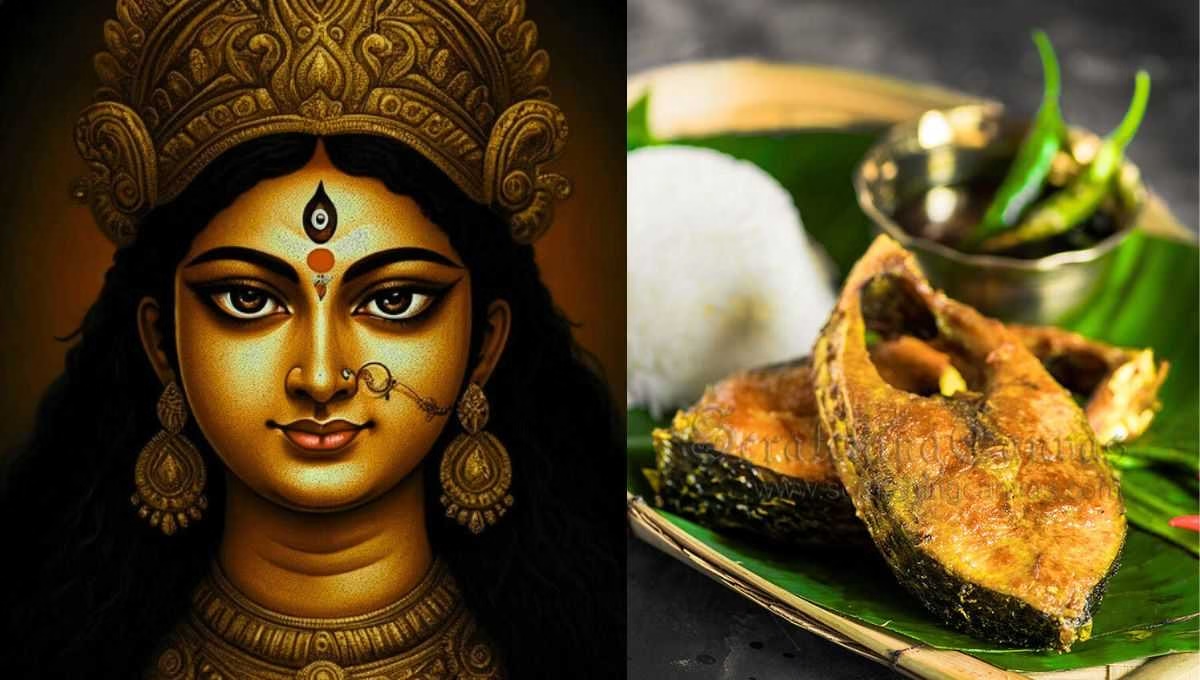Navratri: A unique festival in every state of India. For some, it is a time of fasting, for others, it is a day of devotion. But the picture in West Bengal is completely different. Here, Navratri does not just mean worship, but a wonderful combination of festivals, culture, food and joy.
With the arrival of Durga Puja, the smell of various cuisines along with colorful lights spreads from Bengali homes. Outside, there are pandals and alpana festivals, and at home, various dishes like kasha manas, sarse hilsa, mutton biryani are being prepared.
Why meat and fish again in this religious festival?
Maa has come – A story of joy and enjoyment
For Bengalis, the answer is simple. This is not a rebellion against the rules, but a joyful celebration of the arrival of Maa Durga. According to Shakta religion, offering non-vegetarian food to Maa Durga, Kali and other goddesses is considered sacred. Many temples still sacrifice animals, and the prasad is distributed among the devotees.
There is history behind this belief. Devotees of Shakta religion believe that offering meat and fish is very auspicious to celebrate the power and strength of Maa Durga. Therefore, consuming non-vegetarian food during Durga Puja is not an impure act, but rather an expression of complete devotion.
Bengali food and drink during Navratri
Where Navratri means fasting and eating fruits in North India, it is the opposite in Bengal. During this time, relatives cook various meat and fish dishes together.
The rows of phuchka shops in front of the pandal, the smell of egg rolls, Mughali paratha and kebab stalls all combine to create a food and drink carnival.
Interestingly, inside the pandal, there are vegetarian dishes like khichdi, labra, and payas, but there are non-vegetarian dishes at home. The combination of the simplicity of vegetarianism on one hand and the deliciousness of non-vegetarianism on the other hand creates the completeness of Bengali festivals.
Non-vegetarian festivals in the pages of history
Historian Nrisingh Bhaduri says that non-vegetarian food is a part of festivals in Bengali culture. Fish and meat were easily available in riverine Bengal, so it entered the diet of the common people. Gradually, this habit also found its place in festivals.
Even today, in rural Bengal, animal sacrifices are performed during Durga Puja, and their meat is available as prasad. The practice of that sacrifice may have decreased in the cities, but the tradition of non-vegetarian consumption remains intact.
Bengali festive dishes: A fusion of veg and non-veg
Slow-cooked tender meat, fresh hilsa in mustard sauce, homemade chicken curry made with potatoes, mutton biryani or kebab. Alongside are non-vegetarian khichuri, labra, payas, chutneys, etc. As a result, a perfect coexistence of non-vegetarian and non-vegetarian dishes is created on the same plate.
This fusion is actually a reflection of the Bengali philosophy of life, celebrating the festival with everyone, mixing all tastes.
Read more :- Navratri (Durgapuja) 2025: 9 Colors & Their Spiritual Power
Difference between North and East India: Diversity in food
In Uttar Pradesh, Gujarat or Rajasthan, non-vegetarian dishes like kuttu puri, paneer, sabudana khichuri are served during Navratri. Veg menus are also available in big restaurants in the city under the name ‘Navratri special’.
But in Bengal, it is the exact opposite. Here, non-veg stalls sit next to the Durga Puja pandal, where the aroma of Mughal food wafts from one side and the aroma of hilsa broth from the other.
This difference is actually a reflection of India’s regional culture. Navratri is celebrated with different tastes, colors and rituals in each state.
For Bengalis, Navratri is not just about fasting, but the arrival of Maa Durga on earth—a unique festival filled with colors, songs, the sound of drums and the smell of home cooking.
Here, non-veg food does not diminish devotion, but rather enhances joy. Many families cook lamb meat on special days during Durga Puja, so that everyone’s face will smile at the arrival of Maa Durga.
Read more :-Durga Puja 2025 : Dates , Rituals , Colors & Legends Unfold
The story of the passion and taste of the puja
For Bengalis, Durga Puja is not just a puja, but the name of an emotion. Pandal hopping, offering prayers, watching cultural programs, and eating at the same time, all combine to create a full sensory experience.
Just as the air is filled with the aroma of Maa Durga’s arrival, the kitchen is filled with the aroma of cooked meat.
In this way, the Bengali Navratri is not just a religious ritual, but a complete festival of food, culture and emotions.
In every state of India, Navratri has a different color. Somewhere fasting, somewhere indulgence, somewhere cultural programs. But in West Bengal, Navratri means the arrival of Durga Puja and a fair of non-vegetarian food.
This diversity is what makes India unique. The same festival, but so many different forms!
Therefore, the Bengali Navratri is not just a worship, but a huge festival made up of a combination of food, culture and joy, which satisfies both taste and devotion.
Hi readers. I’m Piyali Batabyal, a passionate blogger who loves to share her thoughts, ideas, and experiences across a variety of topics—from lifestyle and beauty to personal growth and creativity. With a curious mind and a love for words.
Alongside my writing, I am also a professional makeup artist with a flair for enhancing natural beauty and creating transformative looks.
